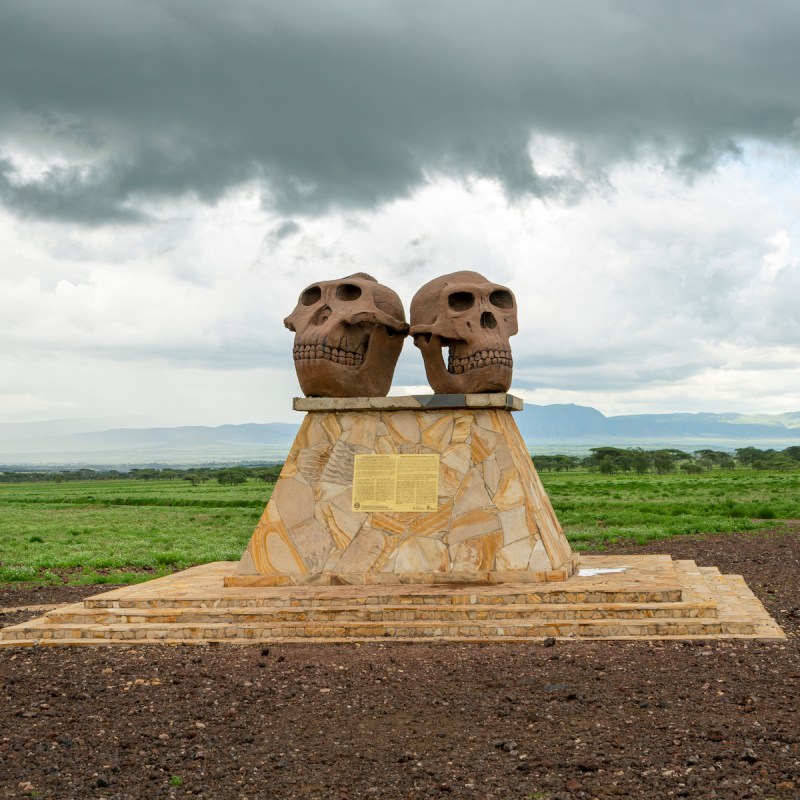
The Northern Safari Circuit is by far the most popular safari destination in Tanzania and it’s home to most of the “absolute-must-see” destinations for a traveler visiting this part of the world. If you’re a Tanzanian first-timer, this is where you want to be. Northern Tanzania covers an area that is full of stunning geographical features and an astounding array of wildlife. Within a relatively compact area, safari goers have access to a multitude of world-famous parks and attractions. The sheer concentration of Africa’s big game in the area is phenomenal, and towering above it all is Kilimanjaro, the world’s highest freestanding mountain.
Videos by TravelAwaits
A northern Tanzania safari should definitely be on your travel bucket list. The land is characterized by geographical extremes. It’s here you’ll find Africa’s highest mountains, alkaline lakes, hot mineral springs, and the Great Rift Valley — a land shaped by volcanic activity. Explore Tanzania from the snows of Kilimanjaro and the fires of Ol Doinyo Lengai volcano to the incredible landscapes of the Ngorongoro Crater, and of course, the world’s largest annual migration of wildebeest and zebra in the Serengeti. The archaeological excavations at Olduvai Gorge offer a window into the history of mankind and away from the tourist hotspots. Lake Natron is the breeding ground for the largest flocks of flamingos on Earth. This is also the land of the Maasai tribe who graze their cattle in this wild and largely uncultivated place, while striding across the landscape dressed in their traditional, vibrant, red shuka robes.
Northern Tanzania is one of the most scenically striking and diverse parts of the continent, so let’s dig a little deeper and explore some of my personal highlights of this fabulous destination.

1. Serengeti National Park
Foremost of the highlights on the Northern Safari Circuit is the Serengeti National Park. Encompassing 5,700 square miles, the immense size of this World Heritage Site national park is greater than the size of Ohio, Belgium, and Wales. Sensational scenery, wide-open grasslands peppered with distinctive flattop acacia trees; this is a truly picturesque landscape. The park is appropriately named after the Maasai word for “endless plains” and you are almost guaranteed to get up close and personal with the “Big Five” — lions, elephants, rhinos, leopards, and cape buffalo — as well as a host of other species. The birds of the Serengeti are just as spectacular and varied as the bigger animals and almost 500 species of birds have been recorded in the park. Add 1.7 million wildebeest, 300,000 zebras, and 400,000 gazelles to the picture and you have a wildlife spectacle second to none. The Great Migration is one of nature’s most incredible spectacles and makes the Serengeti one of the top attractions in Tanzania. The movements of the wildebeest herds are triggered by the annual rains and their search for fresh grazing.
Pro Tip: The Serengeti is often compared to neighboring Maasai Mara National Park in Kenya, but the Serengeti is in fact almost 8 times the size and offers a safari experience that is a little less crowded and a lot more personal.
Where To Stay
Serengeti Under Canvas offers a classic mobile safari experience in the Serengeti. The camp, with its 9 spacious tents, is moved 5 times a year so it’s always in the best location for proximity and access to the migrating herds of wildebeest and zebra.

2. Ngorongoro Crater
The Ngorongoro Conservation Area is where you can find the famous Ngorongoro Crater, the world’s largest unbroken, inactive volcanic caldera. This is another UNESCO World Heritage Site that promises sightings of the Big Five and plenty of other wildlife as well. The caldera measures about 12 miles across and contains an area of around 102 square miles. Its rim rises 2,000 feet above the caldera’s floor, to an elevation of 7,500 feet, and is covered in ancient forests draped in lichen.
The crater promises some of Africa’s best game viewing and is the year-round home for many of Africa’s largest animals including black rhino, black-maned lion, wildebeest, zebra, hippos and buffalo, as well as the continent’s densest population of spotted hyena and some of Africa’s largest elephants. With its stunning landscapes and views, the crater is an exceptional geological landmark.
Pro Tip: The Ngorongoro Crater allows game drives only in the daytime. If you are staying at one of the lodges on the crater rim itself, you can sometimes do a short bush walk around the property.
Where To Stay
Ngorongoro Crater Lodge, perched right on the rim of the crater, offers unbeatable views and is regarded as one of the world’s most luxurious and elegant places to stay. Each suite is decorated with antiques, grand chandeliers, and eclectic African treasures. The bedrooms, sitting rooms, and bathrooms all boast floor-to-ceiling glass windows and overlook the magnificent crater below. Personal butlers are on hand to cater for every guest’s needs.

3. Olduvai Gorge
Within the protected area of the Ngorongoro Conservation Area lies the vast Olduvai Gorge, the birthplace of humankind! The gorge is a steep-sided ravine roughly 30 miles long and 295 feet deep. It was here, in the early 20th century, that famous archaeologist Dr. Louis Leakey uncovered some of the earliest hominid fossils. According to paleoanthropologists, the fossil-rich deposits here cover a time span from about 15,000 to 2.1 million years ago. There’s also a fascinating museum that’s well-worth a visit.
Pro Tip: The name Olduvai originated from a European misspelling of the word Oldupai — the Maasai word for the wild sisal plants that grow in abundance in the gorge.
4. Lake Natron
A remote and not-so-easily accessible landmark, Lake Natron is a particularly good place to visit from August–October, when its shores are populated by nesting pink flamingos. Fed by natural springs, the lake’s waters are rich with a mixture of salts and minerals, called “natron” — hence the name! When water levels decrease in the dry season, the lake’s salts and minerals form a crimson crust over the surface. Remarkably, Lake Natron’s waters are the only regular breeding area in East Africa for 2.5 million lesser flamingos who nest on salty mud platforms and are protected from predators by the toxic water. These fascinating birds have evolved to withstand the lake’s extremely high salt content, where salt-loving microorganisms (phytoplankton) flourish. This gives the lake its red tinge and also feeds the flamingos, who get their pink hue from the algae (cyanobacteria) that they eat.
Backdropped by the dramatic rise of Ol Doinyo Lengai towering in the distance, Lake Natron is a truly special place to be.
Where To Stay
Lake Natron Camp is a unique eco-camp. Set in one of the most visually dramatic locations in the world, the surrounding areas are home to local Maasai tribes, abundant wildlife, and millions of greater and lesser flamingos. With dramatic views of the Great Rift Valley and the majestic Ol Doinyo Lengai, guests can relax with a glass of wine in the camp’s natural spring pool, take a short stroll to the lake, go on hikes, or cool off in nearby waterfalls. A short walk from camp are some well-preserved human footprints estimated to be between 5,000 and 19,000 years old — an incredibly rare find. No other site in Africa has as many ancient homo sapien footprints.
Pro Tip: The best time to see the flamingos is from June–November. Don’t expect to spot much other game while you are here, though. Mammals don’t drink from the lake as the water is toxic for them, though you will likely encounter zebras, wildebeest, gazelles, and perhaps giraffes in the area.

5. Ol Doinyo Lengai
Lake Natron is watched over by Ol Doinyo Lengai, the only active carbonatite volcano in the world and the hardest 1-day hike in East Africa. Here, hikers face a challenging ascent to the top and are rewarded with its incredible views.
An overnight ascent to the 9,718-foot summit of the famous “Mountain of God” — sacred to the Maasai — is an unforgettable experience. Your guide will drive to the bottom of the mountain, about an hour from Lake Natron Camp. The ascent takes around 4–6 hours, with the top third having some very steep and rocky stretches requiring you to be steady on your feet and happy to do some scrambling. The crater itself is quite wide and steep-sided, but walkable, and you can see the boiling lava inside the caldera from the rim. Sunrise is at approximately 6 a.m., at which time you’ll have some great views. The climb down is roughly 3 hours. This is not a trek for the faint-hearted, but it’s worth it for the sense of achievement and unparalleled views — so spectacular they almost don’t seem real.
6. The Footsteps Of Mankind Trek
One of the highlights of northern Tanzania for me is the Footsteps of Mankind Trek. The morning after descending from Ol Doinyo Lengai, I set off on a 3-day hike, starting from the aforementioned hominid footprints, close by to Lake Natron Camp, and going all the way to Olduvai Gorge. Hiking the Rift Valley, passing through traditional Massai lands, and witnessing untouched Massai culture – immersed in places and sights that were far off the beaten track, but with a comfortable campsite to look forward to at the end of the day — made it a really well-balanced adventure. While hiking roughly 6 miles a day, we followed the migration routes that the Massai and their cattle use as they move to find fresh pastures.
Planning Your Trip
It can be quite a challenge to know where and how to start planning a safari. What to include on your list of must-see and must-do spots, especially if this is your first time in Tanzania or even in Africa, can also be challenging. If this is the case, then it’s always advisable to put yourself in the hands of an expert. I was lucky to have Mahlatini Luxury Travel put together a fantastic Tanzanian Odyssey itinerary for me, including all the places I’ve suggested to you above. The itinerary made my trip so easy. I never had to worry about logistics, timings, flight details, or even if I was going to be in the best place, to see the best stuff, at the best time. They took care of all of that!
